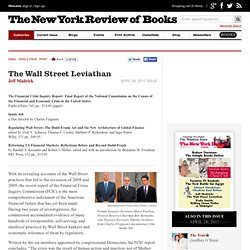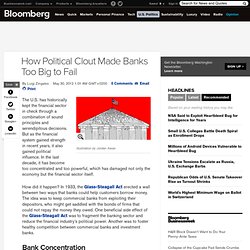

The Wall Street Leviathan by Jeff Madrick. The Financial Crisis Inquiry Report: Final Report of the National Commission on the Causes of the Financial and Economic Crisis in the United States PublicAffairs, 545 pp., $14.99 (paper) Inside Job a film directed by Charles Ferguson Regulating Wall Street: The Dodd-Frank Act and the New Architecture of Global Finance edited by Viral V.

Wiley, 573 pp., $49.95 Reforming US Financial Markets: Reflections Before and Beyond Dodd-Frank by Randall S. MIT Press, 152 pp., $19.95 With its revealing accounts of the Wall Street practices that led to the recession of 2008 and 2009, the recent report of the Financial Crisis Inquiry Commission (FCIC) is the most comprehensive indictment of the American financial failure that has yet been made. Written by the six members appointed by congressional Democrats, the FCIC report concludes, “The crisis was the result of human action and inaction, not of Mother Nature or computer models gone haywire.” The Dodd-Frank Act could have been much more effective. America’s Financial Leviathan - J. Bradford DeLong.
Exit from comment view mode. Click to hide this space BERKELEY – In 1950, finance and insurance in the United States accounted for 2.8% of GDP, according to US Department of Commerce estimates. By 1960, that share had grown to 3.8% of GDP, and reached 6% of GDP in 1990. Today, it is 8.4% of GDP, and it is not shrinking. The Wall Street Journal’s Justin Lahart reports that the 2010 share was higher than the previous peak share in 2006. Lahart goes on to say that growth in the finance-and-insurance share of the economy has “not, by and large, been a bad thing....Deploying capital to the places where it can be best used helps the economy grow...” But if the US were getting good value from the extra 5.6% of GDP that it is now spending on finance and insurance – the extra $750 billion diverted annually from paying people who make directly useful goods and provide directly useful services – it would be obvious in the statistics.
Finally, better finance should mean better corporate governance. Big Bank Chart. John Reed on Big Banks' Power and Influence. BILL MOYERS: Welcome to our third episode about the powerful players in high places who rewrote the rules of American politics and the economy.

You can read all about it in this book: Winner-Take-All Politics: How Washington Made the Rich Richer and Turned Its Back on the Middle Class. If you missed the first two programs, you can see them on our new website, BillMoyers.com. The first is with Winner-Take-All authors Jacob Hacker and Paul Pierson; the second with David Stockman and Gretchen Morgenson on “crony capitalism.” In this edition, we’ll look at a seminal moment when Wall Street and Washington stacked the deck against the rest of us. Remember, this is the political equivalent of a crime story, a mystery. Well it didn’t happen by accident. The richest of the rich was Citigroup, at one time the world’s largest financial institution.
Nicely, thank you. There’s no clearer example of the collusion between government and finance than the deal that created Citigroup in the first place. How Political Clout Made Banks Too Big to Fail. The U.S. has historically kept the financial sector in check through a combination of sound principles and serendipitous decisions.

But as the financial system gained strength in recent years, it also gained political influence. In the last decade, it has become too concentrated and too powerful, which has damaged not only the economy but the financial sector itself. How did it happen? In 1933, the Glass-Steagall Act erected a wall between two ways that banks could help customers borrow money. The idea was to keep commercial banks from exploiting their depositors, who might get saddled with the bonds of firms that could not repay the money they owed. Guest Post: Giant Banks Now 30% Bigger than When Dodd-Frank Financial “Reform” Law Was Passed.